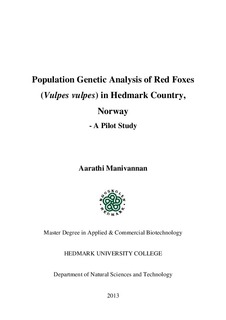Population Genetic Analysis of Red Foxes (Vulpes vulpes) in Hedmark Country, Norway - A Pilot Study
Abstract
Ecological and environmental studies commonly depended on the knowledge of genetic
variation among individuals within a population and most of the population studies were
carried out using genetic markers. In this thesis, individuals of Vulpes vulpes species were
genotyped using microsatellite markers to study their population diversity. DNAs were
isolated successfully from the muscle tissues of 33 individuals and in some cases, from the
hair and scat of the foxes. Twenty microsatellite primers with 1 sex chromosome marker
were successfully designed using MP primer downloaded program out of which 16 primers
amplified the DNA template samples successfully. The Amplicons were successfully
genotyped and checked for genotyping errors. The LOSITAN program identified two of the
markers to be under selection and the Micro-Checker program adjusted the alleles, which
were identified as ‘null’ alleles. The analysis was performed on three different types of data:
original genotype data, adjusted genotype data with the null allele markers and genotype
data without the null allele markers. The marker under balanced selection was also added to
verify its effect on the study. The STRUCTURE program assembled the individuals into
different clusters. The Arlequin program estimated that the individuals grouped using
original genotype data proved genetically variable, whereas individuals grouped using
adjusted null alleles did not show any significant variance. Original genotype data looks
promising as the loci were not significantly in Linkage Disequilibrium but this can be
justified by increasing the number of individuals for the study. Analysis using genotypic
data without null allele markers did not vary from the analysis using original genotypic
data. Addition of marker under balanced selection showed significant Linkage
disequilibrium in the study of all the three types of data. Relationship between the
individuals showed that many individuals were half- siblings and 4 of them were full
siblings.
Description
Mastergradsoppgave i næringsrettet bioteknologi, Avdeling for lærerutdanning og naturvitenskap, Høgskolen i Hedmark, 2013. Master of applied and commercial biotechnology.
